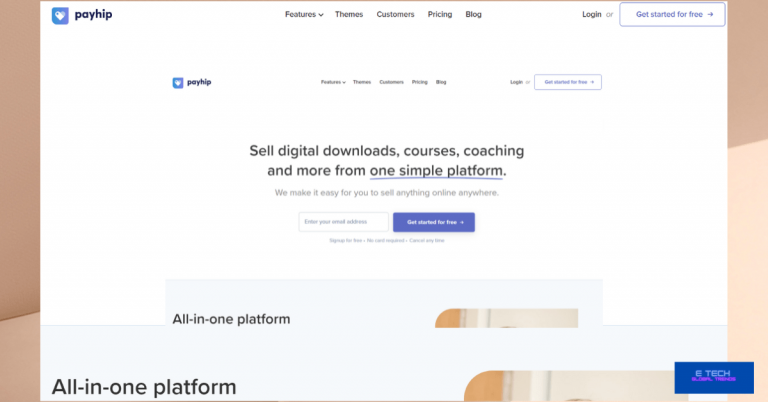Native Cloud Computing
You know this term already “ cloud computing”. But what does mean “Native”? Of course, this is a fresh technological concept. Would you like to check that? So, today’s presentation is about “ Native Cloud Computing”.
Stay tuned until the end!
What is native cloud computing?
The term “native cloud computing” describes the development and implementation of services and applications especially for cloud environments. It makes the most of the features and capabilities offered by cloud platforms.
With this method, there are Apps with cloud-native concepts like scalability, resilience, agility, & flexibility in mind.
Native cloud computing has several important features,
such as:
1.0 Microservices Architecture:
Programs may be independently created, deployed, and scaled by breaking them up into smaller, loosely connected services. This method promotes continuous supply and allows for agility.
Containerization is the process of packaging programs and their dependencies into containers, like Docker, to ensure consistency across various environments and make deployment and scaling easier.
2.0 Orchestration:
Containerized application deployment, scaling, and administration are automated with the help of tools such as Kubernetes. They facilitate the management of complicated distributed systems by offering capabilities for load balancing, self-healing, and service discovery.
3.0 Serverless Computing:
Platforms for serverless computing, such as AWS Lambda or Azure Functions, allow developers to concentrate on creating code rather than worrying about maintaining the underlying infrastructure. This is a common feature of native cloud applications. This enables usage-based cost optimization and automated scalability.
Infrastructure that is version-controlled and handled like code is known as immutable infrastructure. With every upgrade, new infrastructure installations are there rather than altering the current servers, which encourages consistency and dependability.
4.0 DevOps Practices:
With an emphasis on automation, continuous integration, and microservices, native cloud computing fosters a culture of cooperation between development and operations teams and continuous deployment (CI/CD) pipelines.
Application characteristics like;
- Redundancy
- Auto-scaling, &
- Fault isolation
are included to make them resilient to failures. This is known as fault tolerance. High availability and dependability are therefore guaranteed.
In today’s fast-paced digital market, enterprises may offer value to their consumers more effectively by adopting native cloud computing strategies, leading to enhanced agility, scalability, and cost-effectiveness.
- Scalability,
- Resilience, and
- Agility
These 3 concepts are using in cloud-native computing. a strategy for software development and deployment that uses cloud-computing resources.
It involves leveraging containerization, microservices architecture, & dynamic orchestration to design apps tailored for cloud settings.
But, why?
Are there real benefits?
7 significant cloud-native computing’s advantages
1. Scalability:
Applications built with cloud computing infrastructure can grow horizontally and vertically in response to changing needs, allowing for effective resource management and cost reduction.
2. Resilience:
Cloud-native apps can smoothly handle errors and disturbances, guaranteeing high availability & fault tolerance, by using distributed systems and redundancy.
3. Agility:
Cloud-native apps are made to be developed and deployed quickly, which enables businesses to release updates and new features, iterate quickly, and react to changes in the market.
4. Cost-efficiency:
By maximizing resource consumption and lowering infrastructure overhead, cloud-native designs leverage pay-as-you-go, auto-scaling, and on-demand resource provisioning to achieve cost savings.
5. Portability:
One of the main features of cloud-native computing is containerization, which allows apps to be packaged together with their dependencies and therefore be portable to other cloud environments and providers.
6. DevOps Support:
Cloud-native solutions complement DevOps methods effectively, promoting communication between the development and operations departments, optimizing deployment processes, and facilitating continuous integration & delivery.
7.0 It’s easy to handle
Because native cloud apps use automation for both feature and update deployment, they are simple to maintain.
Additionally, it makes it risk-free for developers to track components and microservices. If necessary, developers can additionally keep tabs on a particular microservice.
Cloud-native computing, on its whole, drives innovation and shortens time to market by empowering enterprises to create and manage very scalable, robust, and agile applications that capitalize on cloud infrastructure rewards.
What is a native cloud application?
A program created specifically for a particular cloud computing architecture is what makes an application cloud-native. cloud native Apps support Software-as-a-service (SaaS) deployment model features. which often executes and hosts in the cloud.
To improve performance and scalability, microservices are packed as lightweight containers in the development of these applications.
With the help of these apps, businesses may create and execute apps in public, private, and hybrid cloud environments, among other kinds.
A native cloud software supports a particular device or platform.
How do Native Cloud applications help to improve B2B operations?
Indeed, native cloud apps have the following benefits for B2B operations:
Enhanced flexibility and expandability:
The modular and microservices-based architecture of cloud-native apps enables quick development, deployment, and scalability in response to changing business requirements. This flexibility enables B2B businesses to promptly adjust to shifting consumer needs and market situations.
Without having to buy and manage your infrastructure, cloud providers enable you to scale your apps up or down as needed simply. Costs can be reduced, and resource usage can be enhanced.
Increased cooperation and output
Cloud-native apps enable remote teams to work together efficiently since they can be accessible on any device, at any time, and from any location.
For B2B enterprises with regionally distributed workers or customers, this is extremely advantageous.
Cloud-based collaboration solutions can enhance workflow and communication even further, resulting in higher output and efficiency.
Enhanced compliance and security
Cloud providers meet the privacy and data security requirements of B2B enterprises, which make significant investments in compliance certifications and security procedures.
Sensitive data can be further protected by the built-in security features that cloud-native apps frequently include, like encryption and access controls.
Lower expenses:
The cost savings from using cloud-native apps can be substantial since they remove the need to purchase and manage your infrastructure.
Pay-as-you-go pricing models are available from cloud providers, allowing you to only pay for the services you utilize. This can help you keep your IT spending under control.
Additional advantages
Disaster recovery
Because data and apps can be readily backed and then replicated across multiple regions, cloud-based systems are intrinsically more resilient to calamities than on-premises applications.
Innovation
A vast range of cutting-edge services and tools are available from cloud providers to assist B2B businesses in creating new goods and services, enhancing customer satisfaction, and gaining a competitive advantage.
What are the cloud native computing instances?
1.0 Supply chain management:
Real-time supplier collaboration, inventory tracking, and logistics management are all possible with cloud-based apps.
2.0 CRM- Customer relationship management:
B2B organizations can manage sales funnels, track customer interactions, and deliver superior customer service by utilizing cloud-based CRM systems.
3.0 ERP -Enterprise Resource Planning:
Cloud-based ERP solutions can combine customer, operational, and financial data from B2B businesses into a single system, increasing productivity and reporting.
All things considered, native cloud apps have certain advantages that can improve the agility, effectiveness, and security of B2B operations.
It’s crucial to thoroughly assess your needs and select a provider of cloud services that can satisfy them if you’re thinking about moving your apps to the cloud.
What are the existing native cloud computing instances?
It is the accepted practice for developing contemporary applications.
1.0 Kubernetes:
This open-source container orchestration platform handles the deployment, scaling, and administration of containerized applications automatically.
2.0 Docker
is a platform for containerization that lets you build, run, and maintain containerized applications.
- Docker containers can be easily run on Amazon Web Services with the help of Amazon Elastic Container Service (ECS), a managed container service.
- Microsoft Azure’s managed container service, Azure Container Service (AKS), makes it simple to run Docker containers on the cloud.
- The Google Cloud Platform can operate Kubernetes more easily with the help of Google Kubernetes Engine (GKE), a managed Kubernetes service.
There are numerous cloud native technologies available; these are just a handful of them.
Additional cloud native technologies
Other devices and software
1.0 Infrastructure as Code (IaC):
Provisioning and administration of infrastructure is now available with automation and the use of tools like Terraform & Ansible.
Microservices are managed by technologies such as Istio, which also offers characteristics like observability and security.
2.0 Serverless Functions:
You can run code without creating or managing servers with platforms such as AWS Lambda & Azure Functions.
3.0 API Gateways:
API traffic is managed and security and governance capabilities are offered by gateways such as Apigee and Kong.
4.0 Monitoring and Observability:
Programs like Grafana and Prometheus give you information about the functionality and state of your applications.
What are the cloud native tool settings that an entrepreneur should carefully consider?
Selecting the best cloud-native tools for your business requires you as an entrepreneur to weigh more than just the technology.
Here are a few crucial factors to carefully evaluate:
Everything has to plan properly. Brainstorm properly. As well as don’t expect that fresh technology will handle all perfectly. Needs Continuous focus and maintenance with additional care.
1.0 Business Requirements:
Of course, we discussed these facts earlier. Due to the importance, we mention it again plus added facts.
Scalability: Is the tool able to accommodate the expansion you expect?
Performance: Does it satisfy the dependability and speed requirements of your application?
Security: Does it safeguard your data and apps with strong security measures?
Cost: Does it provide the best value for your demands and fit into your budget?
Conformity: Does it adhere to pertinent industry standards?
2.0 Teams & Growth:
Usability: Is it easy enough for the skill level of your team to use?
Open Source compared to Commercial: Does the technology have enough experienced developers, or do you require outside assistance?
Documentation & Community: Does a robust support community and easily accessible resources?
Integration: Is it able to operate in unison with the infrastructure and tools you already have?
Lock-in of the vendor: Steer clear of tools that restrict your flexibility by locking you into a certain vendor.
3.0 Long-Term Goals:
Future Roadmap: Is the tool up to date with industry trends and has a clear development roadmap?
Flexibility: Is it able to change to fit your changing needs and company plan?
Sustainability: Does it rest on dependable, up-to-date technologies?
Innovation Potential: Does it have attributes that set your product or service apart from the competition?
Likewise, there are critical aspects that you have to consider.
4.0 Extra elements
Vendor Reputation: Select dependable suppliers with a solid history of performance and customer service.
Data Privacy: Verify that the tool conforms with the laws governing data privacy that apply to your company.
Free Samples & Conceptual Proofs: Make full use of POCs and trials that are available to test and assess tools.
Why do you want to have a strategy for dealing with cloud-native tools?
Remember that there isn’t a solution that works for everyone.
Sort the parameters according to how well they match your team, long-term vision, and particular business goals.
You can select cloud-native solutions that support your business endeavors by carefully weighing these factors.
The optimal cloud-native technology for you will be determined by several variables,
such as;
1.0 The scale and intricacy of your application:
While smaller apps could be OK with a monolithic approach, larger apps might gain more from microservices.
2.0 The qualifications and experience of your development team:
Select technologies that your team members are willing to learn or are familiar with.
3.0 Your spending plan:
Commercial licenses are required for certain technologies, whereas others are freely available.
3.0 Your unique requirements:
Are you in need of security, fault tolerance, or high scalability? Select the technologies that best meet your unique needs.
Would you like to discover more about cloud-native technology?
Check out these too!
- A non-profit organization called the CNCF-Cloud Native Computing Foundation promotes the advancement and uptake of cloud-native technologies.
- Cloud Native Interactive Landscape: This is an ecosystem depiction of cloud-native technologies.
- Cloud Native Patterns: A collection of patterns for creating cloud-native applications can be found on the Cloud Native Patterns website.
Summary
In summary, businesses can create and deliver contemporary apps more quickly when they choose a cloud-native approach driven by;
- Microservices,
- Automation,
- Flexibility, and
- Resilience.
Hope this content helps.
Cheers!
Read more on related topics here Cloud Security Tools, Cloud Computing







